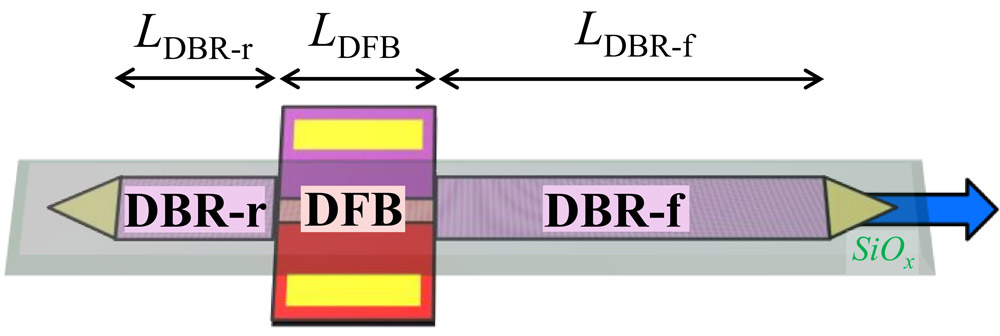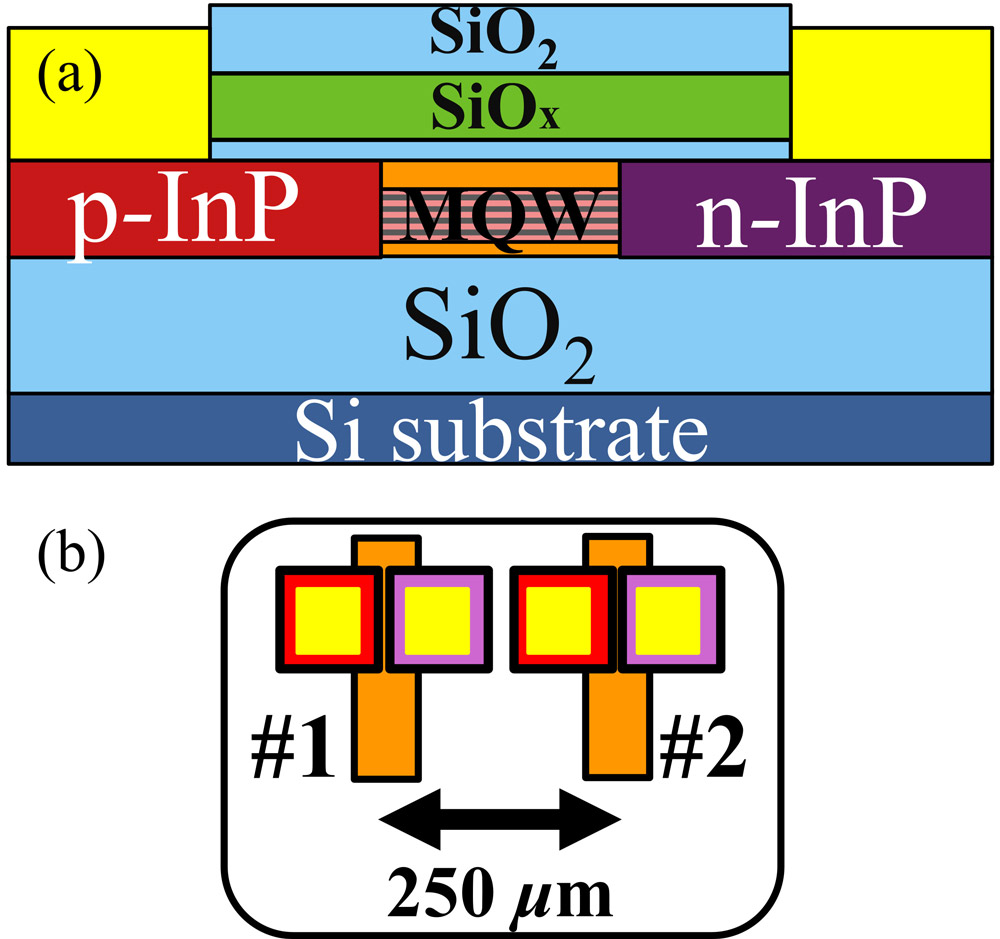News: Optoelectronics
17 March 2022
High-bandwidth membrane III-V lasers on SiO2/Si
Nippon Telegraph and Telephone Corporation (NTT) and Waseda University in Japan have reported a 26% increase in 3dB bandwidth to 60GHz for its two-channel energy-efficient directly modulated membrane laser (DML) arrays on a silicon dioxide/silicon (SiO2/Si) platform [Nikolaos-Panteleimon Diamantopoulos et al, IEEE Journal of Lightwave Technology, published online 23 February 2022].
Such arrays are being developed for higher data rates in data centers and high-performance computing systems linked by optical fiber. The 60GHz bandwidth brings in sight 200-400 gigabit per second (Gbps) transmission with simple modulation techniques.
DMLs on much more expensive high-thermal-conductivity silicon carbide (SiC) can achieve 108GHz 3dB bandwidths, but the team sees the deployment on silicon as “being a critical step towards achieving low-cost production via large silicon wafers”.
The researchers increased the bandwidth by enhancing photon-photon resonance (PPR) effects through careful design of the logitudinal modes of the laser cavity.
The laser cavity consisted of a rear distributed Bragg reflector (DBR-r) that was detuned from one of the two main resonant wavelengths of the distributed feedback (DFB) section on the multiple quantum well structure (Figure 1). The front section consisted of a DBR (DBR-f) with a similar wavelength response as the DFB. The aim of the detuning was to single out the non-detuned wavelength.

Figure 1: Longitudinal laser design for photon-photon resonance.
The lengths of the sections were optimized to increase the PPR frequency to 50GHz, a 10GHz increase over the group’s previous work. In particular, the DFB section length was reduced to 80μm from 100μm previously.

Figure 2: Fabricated laser array structure: (a) cross section; (b) two-channel laser array chiplet.
The membrane DBR laser consisted of a buried MQW heterostructure between lateral p- and n-type indium phosphide (InP), giving a PiN junction (Figure 2) on SiO2/Si substrate. The total thickness of the III-V membrane was 350nm. The laser structure itself consisted of a 600nm core of indium gallium aluminium arsenide (InGaAlAs) layers with 103nm MQW active region aimed at O-band operation (1260-1360nm). NTT/Waseda use selectiv-area growth on directly bonded InP on SiO2/Si to produce such structures.
The light from the 2-laser array was coupled into standard single-mode fibers (SSMFs) using a spot-size converter consisting of an InP taper and SiOx waveguide in SiO2 cladding. The channels were separated at 250μm pitch to avoid electrical and thermal crosstalk.
The laser output under modulation varied with frequency for both devices at 25°C, falling by 3dB relative to the DC performance at around 60GHz. The 3dB bandwidth of the group’s previous work was around 47GHz.
With a view to practical implementation, the team performed a number of short-reach tests using 112Gbps non-return to zero (NRZ) and 100GBaud four-level pulse-amplitude modulation (PAM-4) (200Gbps) signals. No crosstalk was detected between the two channels. The operating powers for NRZ signals were around 26mW and 35mW for the separate devices. The difference in power was due to fabrication variations.
The bit-error rates (BERs) after NRZ transmission over 2km of SSMF met the standards for 200/400Gbps Ethernet with KP4 forward-error correction (KP4-FEC). The laser operating powers were equivalent to 0.24pJ/bit and 0.31pJ/bit for the respective channels, or 0.29pJ/bit combined.
The PAM-4 modulation did not manage the BER needed for KP4-FEC, but it did manage, with respective BERs of 1.58E-2 and 7.25E-3, the more relaxed threshold for hard-decision FEC (HD-FEC), but with higher power consumption and latency.
The researchers also considered the performance at up to 75°C with a view to implementations without special cooling systems. At the higher temperature, the 3dB bandwidth reduced to 45GHz, which could be adequate for 100Gbps-class PAM-4 signals, according to the team. The optimum bias current was increased slightly to 16.3mA from 14.1mA at 25°C. The researchers comment: “Since the bias current deviation is only within ±1.1mA, simple control electronics, typically found in DML transmitters, can be utilized as real-time adjustment mechanisms for the bias currents, without any need for costly and extra power-consuming heaters.”
III-V lasers DBR-r InP InGaAlAs
https://doi.org/10.1109/JLT.2022.3153648
The author Mike Cooke is a freelance technology journalist who has worked in the semiconductor and advanced technology sectors since 1997.









